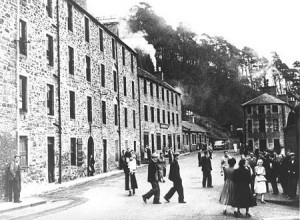I’m pondering what to write about Erik Olin Wright’s [amazon_link id=”184467617X” target=”_blank” ]Envisioning Real Utopias[/amazon_link], for a debate in the New Year over at Crooked Timber. The book has a few examples of ‘real utopias’ – the Mondragon co-operative, Wikipedia – but only a few. It set me pondering about putting utopianism into practice. Of course, the internal contradiction of ‘real utopias’ is intentional. Thomas More knew no such societies were possible when he wrote the original [amazon_link id=”0140449108″ target=”_blank” ]Utopia[/amazon_link]. As in so many socially progressive movements, the Victorians were the real pioneers. Robert Owen is one of my favourites, manager of a Manchester mill and a member of the Manchester Literary and Philosophical Society before going on to turn New Lanark into a ‘real utopia’.
I’ve not read much of Owen’s work, and that a long time ago, but found certainly in my youth found it hard to disagree with any sentiment he expressed in [amazon_link id=”0140433481″ target=”_blank” ]The Social System[/amazon_link] (1826): “To train and educate the rising generation will at all times be the first object of society, to which every other will be subordinate”. And in New Lanark he put into practice his view about the importance of early intervention, more than a century and a half before this truth was rediscovered in modern policy: “The Institution has been devised to afford the means of receiving your children at an early age, almost as soon as they can walk. By this means many of you, mothers and families, will be able to earn a better maintenance or support for your children; you will have less care and anxiety about them, while the children will be prevented from acquiring any bad habits. and gradually prepared to learn the best”. (Address to the Inhabitants of New Lanark, 1816). New Lanark didn’t close as a working mill until 1968.
Although I can think of other utopias, imagined ones of early modern times and actual ones in Victorian times, existing modern ones are hard to find examples of. Any suggestions?

New Lanark in the 1950s, from http://www.undiscoveredscotland.co.uk/lanark/newlanark/index.html
